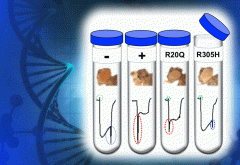Topics
Fruit fly study links TBX2 to a novel Mendelian disorder

An interdisciplinary team has found a link between TBX2, a member of the T-box family of transcription factors, to a novel disorder that mainly affects the cardiac, skeletal, immune and endocrine systems. By using a powerful combination of sequencing analyses of patients’ DNA, database searches and functional studies in cultured cells and fruit flies, researchers uncovered a potential pathogenic link between missense variants in TBX2 gene and a new developmental disorder. The study appears in the journal Human Molecular Genetics.
“Typically, researchers try to model human diseases in model organisms such as mice by creating gene mutations that mimic human symptoms. This study shows that fruit flies can be used to quickly provide functional information on rare and potentially disease causing mutations, akin to “live test tubes” to assay the effects of genetic variants on various biological processes and pathways," said corresponding author Dr. Shinya Yamamoto, assistant professor in molecular and human genetics at Baylor College of Medicine and investigator at the Jan and Dan Duncan Neurological Research Institute at Texas Children’s Hospital. “Using morphological and functional assays in fruit flies and cultured cells, we have uncovered a link between the congenital heart defects, skeletal abnormalities, immune and endocrine defects in four patients to partial loss-of-function of the transcriptional factor TBX2”.
The study initiated with a seven-year-old boy who presented with a congenital loss of thymus and functional immune cells, cardiac and skeletal defects, dysmorphic craniofacial features along with some signs of autistic behaviors. He was thought to have many features commonly seen in children with 22q11.2 deletion syndrome, also known as DiGeorge syndrome.
Interestingly, two of his family members (his sister and mother) also exhibited similar defects, albeit in a milder form. However, surprisingly, none of them carried the 22q11.2 chromosomal deletion or had alterations in theTBX1 gene which is located within this interval. This spurred Duke University investigators, Drs. Vandana Shashi, Loren Pena, and genetic counselor Kelly Schoch, who are a part of the Undiagnosed Disease Network to perform whole-genome sequencing analyses on this family.
These tests revealed the presence of a rare missense variant (p.R20Q) in the TBX2 gene in all three affected family members. In order to identify additional patients with rare variants in this gene, the team used GeneMatcher, a website developed by the Baylor-Hopkins Centers for Mendelian Genetics that connects physicians and researchers who share an interest in the same gene. This led to identification of a fourth patient seen by physicians at Cook Children's Hospital in Fort Worth, Texas, who shared many of the same clinical features with the initial patient but carried a different missense variant (p.R305H) in TBX2.
TBX2 belongs to the T-box family of evolutionarily conserved transcriptional factors that play crucial roles in the embryonic development of the heart, limbs, digits, and brain regions. Alterations in 12 out of the 17 members of this gene family have been identified as causes of diverse multi-organ developmental syndromes in the past.
Further analyses by postdoctoral fellows Drs. Ning Liu and Xi Luo at Baylor College of Medicine in a human cell line found that the patient’s TBX2 variants decreased the level of TBX2 protein and led to reductions in their ability to suppress the expression of its target genes.
“Determining the functional consequences of missense mutations such as these ones – mutations that change a single amino acid in a protein – is still very difficult, even with the help of various bioinformatics tools,” said Yamamoto.
Here is where the fruit fly came in. To further evaluate the biological significance of TBX2 mutations on complex signaling pathways in an intact animal, several in vivo fly assays were performed in the laboratories of Drs. Shinya Yamamoto, Michael Wangler, and Hugo Bellen who oversee the UDN’s Model Organism Screening Center, at Baylor College of Medicine.
“The human and fly circulatory and immune systems are structurally different, and flies do not have an endoskeleton system. Therefore, in this study, instead of using flies to model the symptoms found in patients, we used them as a tool to rapidly identify the functional consequences of TBX2 variants. Bifid, the fly homolog of human TBX2 is known to be important for the proper development of the fly, especially for the visual and nervous systems. So, we used development and retinal function of adult fly eyes as a readout for transcriptional repressor activity of TBX2 gene,” said Yamamoto.
Consistent with the results from in vitro experiments, they found overexpression of TBX2 variants in flies moderately affected eye development, retinal function and lifespan, all of which unequivocally points to the pathogenic potential of these variants.
“This study provides a blueprint of how fruit flies can be used as a rapid screening tool to identify and understand the function of potentially pathogenic human disease genes,” said Yamamoto.




